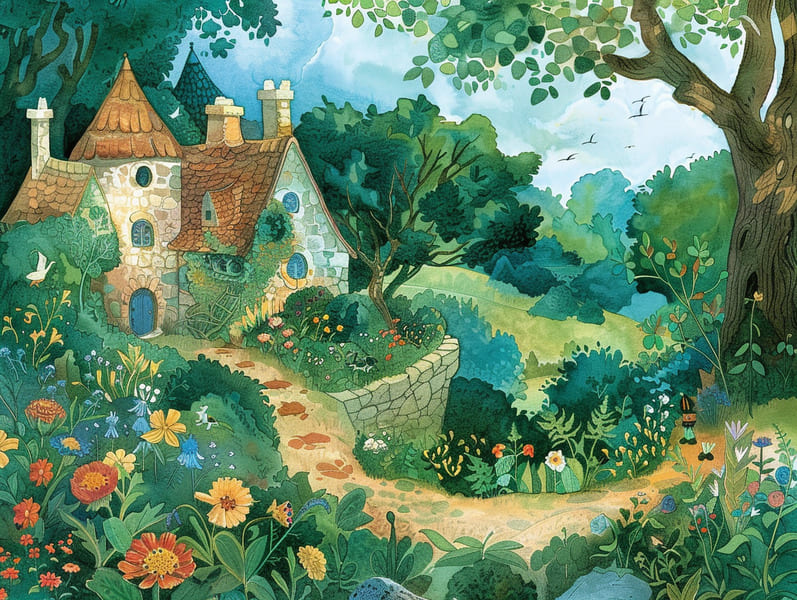The Story Behind Ancient Fairy Tales with the Unceasing Enchantment.

Short fairy tales have ancient roots. These stories have been narrated from one generation to the next centuries before they were ever recorded. They developed from a variety of cultures, including Western traditions. They were initially conveyed among elders, often carrying themes and messages mirroring the societal norms and beliefs of the time.
Jacob and Wilhelm Grimm, Jacob and Wilhelm, were among the first to gather and publish many of these beloved fairy tales. Their anthology, "Grimm's Fables," included classics like "The Little Glass Slipper," "Little Brother and Little Sister," and "Snow White," which have since become cornerstones in the world of classic fairy tales. Similarly, Hans Andersen's charming fairy tales, such as "The Little Mermaid," and "The Little Duckling," have floated into hearts worldwide, securing their place in the pantheon of beloved fairy tales.
Despite their age, these stories remain as meaningful as ever, especially as nighttime stories for kids. These charming stories are now available in various formats, including richly illustrated books, fantastical animations, and digital storybooks.
Their lasting presence can be linked to several charming aspects:
Life Lessons: Timeless fairy tales often convey important moral lessons. Narratives like "The Boy Who Cried Wolf" teach the significance of honesty, while "The Story of the Tortoise and the Hare" point out the benefits of resolve and humbleness. These tales offer young readers clear distinctions between good and bad, building their moral compass in a soft yet meaningful way.
Sympathy and Perception: Traditional fairy tales frequently include protagonists facing tests and troubles, provoking listeners to empathize with their struggles and boost their triumphs. For instance, "The Story of Beauty and the Beast" demonstrates the virtue of valuing inner qualities to recognize the true being of a being, advancing awareness and knowledge.
Cultural Awareness: Many ancient fairy tales are steeped in the cultural contexts from which they originated. Understanding these narratives can provide intriguing perspectives into different cultures, promoting a sense of world appreciation and comprehension.
Creativity and Imagination: The fantasy-filled elements in old fairy tales—talking animals—ignite children’s fantastical thinking. These fairy tales bring readers to extraordinary realms, unleashing innovative thinking and a sense of excitement that stays a lifetime.
Timeless fairy tales are not only captivating but also edifying. They work as spellbinding tools in strengthening various thinking and feeling skills in young ones. When old fairy tales are recited, they improve language acquisition by teaching new terms and meanings and sophisticated sentence structures. This practice also advances listening skills and concentration, as kids stay focused, prepared to see what happens next.
Furthermore, deliberating the themes and characters of fairy tales can develop evaluative skills and cognitive skills. Little ones are taught to discern patterns, guess what will happen, and grasp cause and effect. These explorations also ease the young utter their thoughts and feelings, adding to their emotional intelligence.
In today’s electronic age, the accessibility of online storybooks has made these narratives more available than ever. Internet resources and mobile apps give broad selections of timeless fairy tales that can be looked at or heard anytime, website anywhere. Fairy tales read out loud are particularly popular, sharing an fun way for children to experience these whimsical stories. Audiobooks and narrated videos transport characters and settings to life, often paired with fantastical soundtracks and songs that elevate the storytelling experience.
The timeless allure of old fairy tales lies in their ability to adjust to new eras while continuing with their main lessons. Contemporary updates of these narratives often spotlight more multicultural characters and modern settings, making them familiar to today’s audience. However, the core values of fearlessness, benevolence, and even-handedness remain unchanged, continuing to resonate with young listeners of all ages.
Old fairy tales also offer a sense of familiarity and predictability. They offer a tidy narrative with a straightforward beginning, middle, and end, often finishing with the culmination of conflicts and the triumph of goodness over badness. This uniformity can be comforting for little ones, proffering a sense of steadfastness in an variable world.
Ancient fairy tales continue to mesmerize and teach new generations, maintaining their beauty and relevance in modern society. As children's bedtime stories, they distribute a perfect blend of allure and teaching, fostering moral values, empathy, and creativity. The existence of internet fairy tales and the commonness of fairy tales told out loud make sure that these timeless tales remain reachable to new generations.
By perpetuating and telling these fairy tales, we continue to venerate the rich tapestry of myths and cultural heritage. Whether you are reading a beautifully illustrated book, delving into a internet collection, or hearing an read-aloud story, the enchantment of timeless fairy tales is always within reach. These fairy tales illustrate of the unfading power of stories and its ability to bind us across centuries and lands.
Be it you are discovering a vibrantly illustrated book, viewing a cyber library, or listening through an read-aloud story, the grandeur of ancient fairy tales is always within reach.
These narratives point out of the consistent influence of narratives and its ability to unify us across time and space, making a tie that enchants and educates alike.